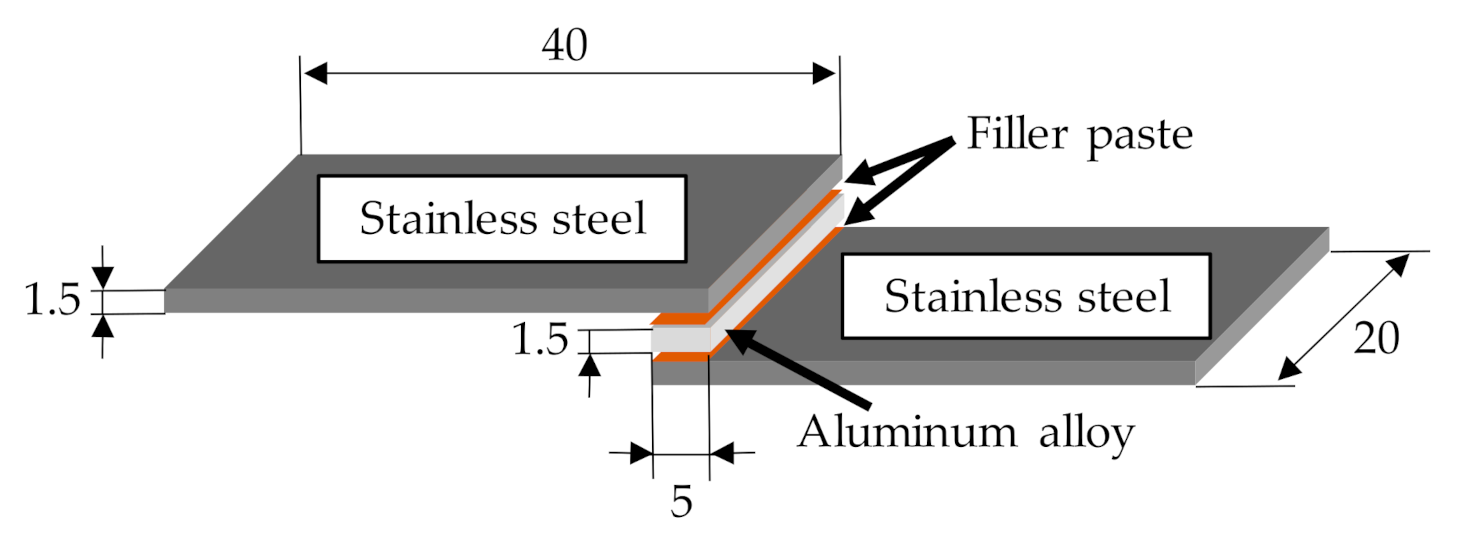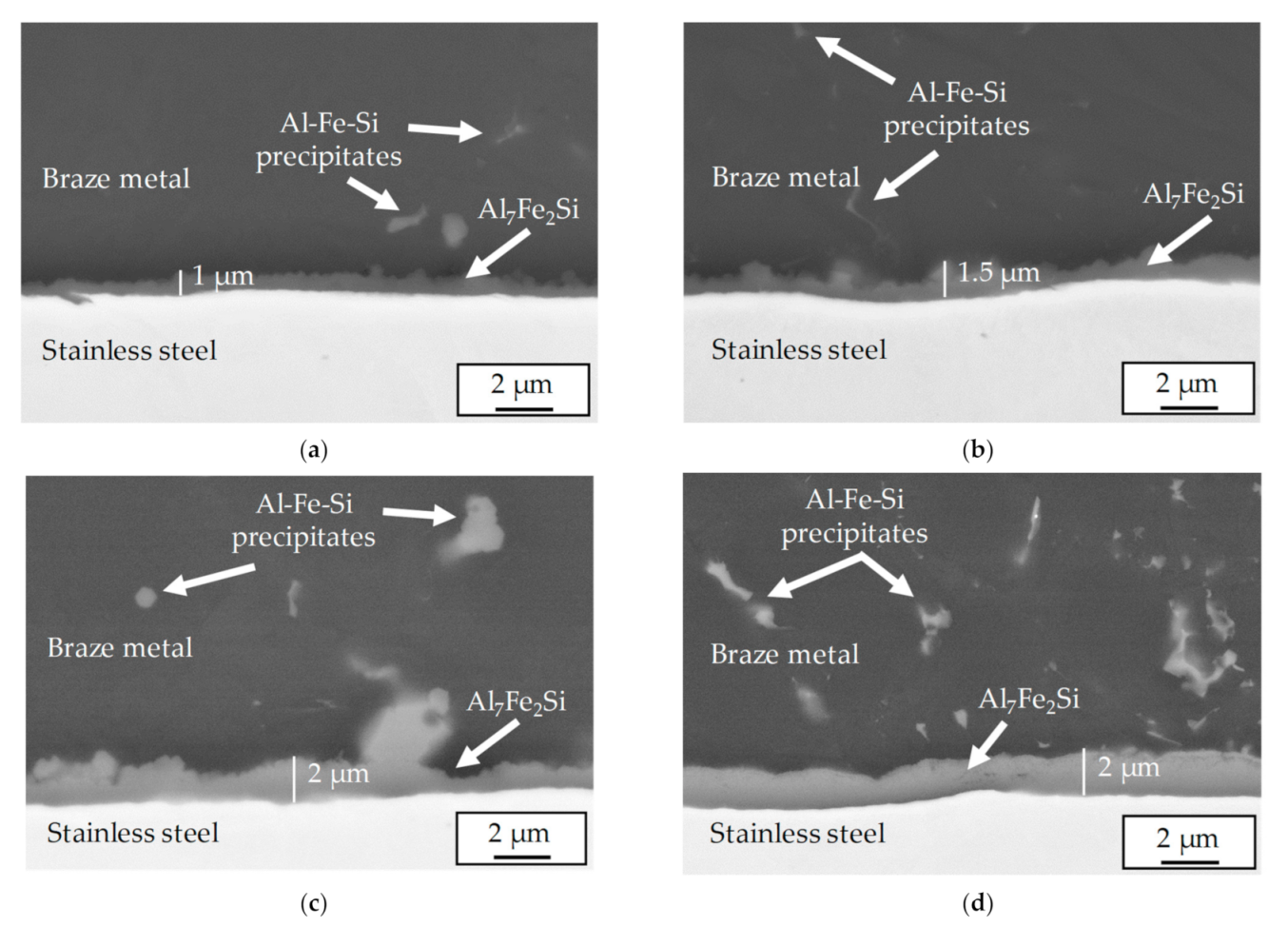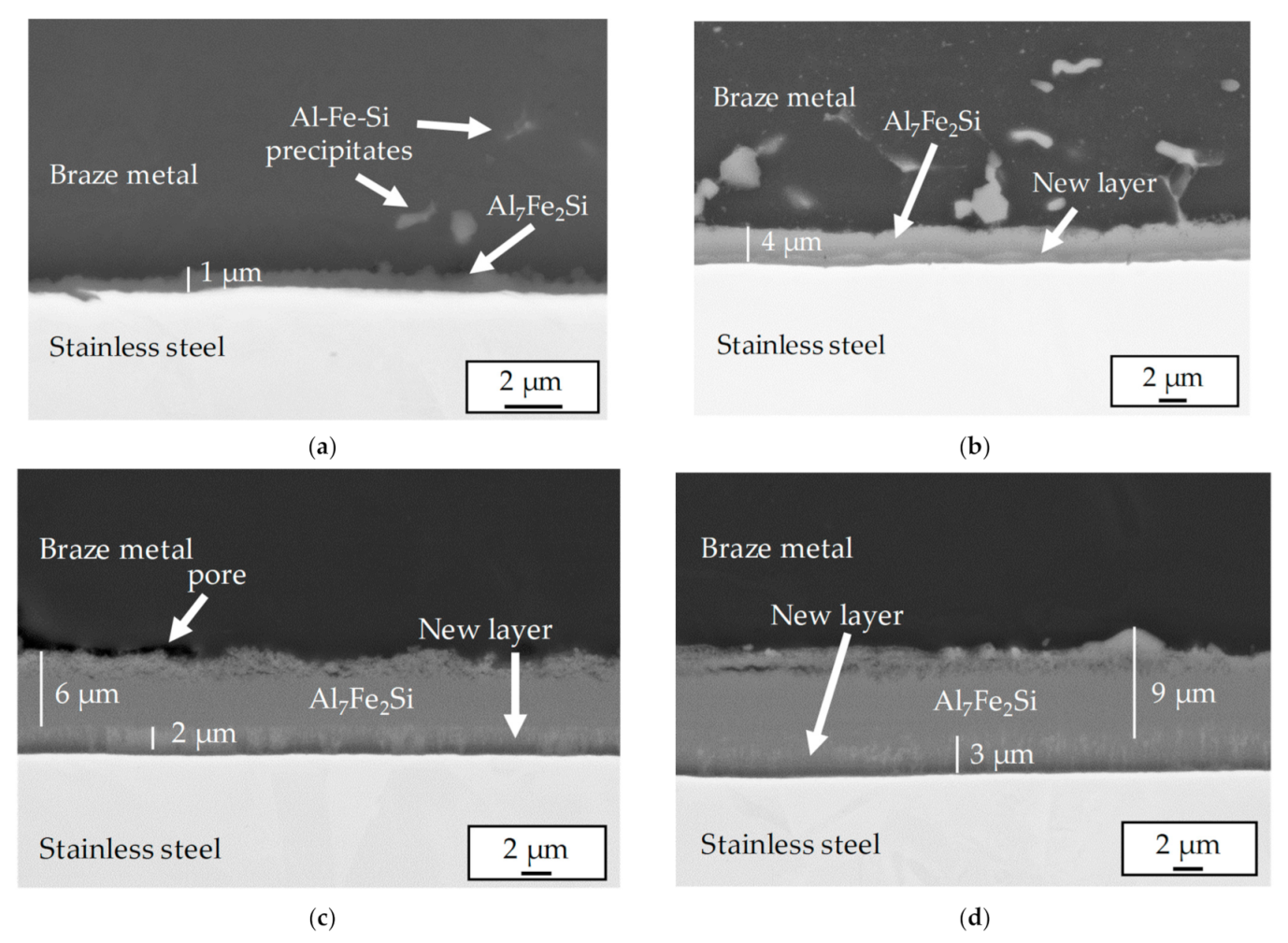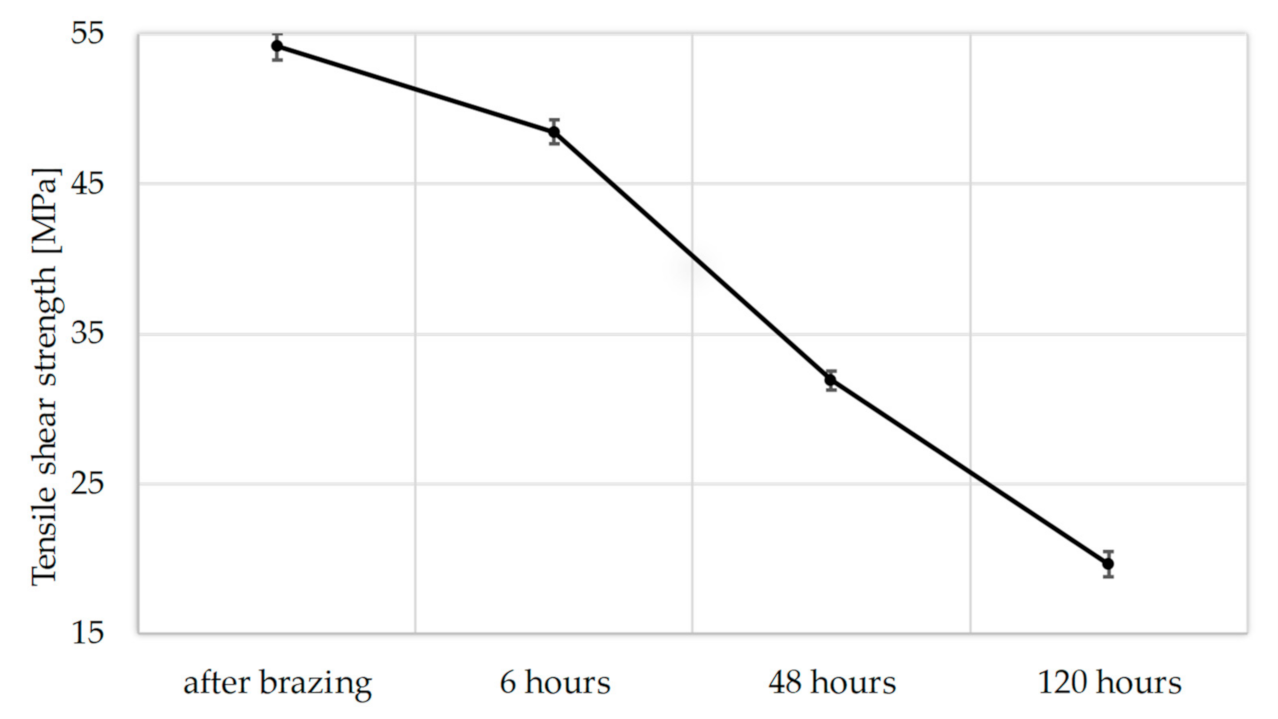Influence of the Thickness of the Reaction Zone in Aluminum/Stainless Steel Brazed Joints on the Mechanical Properties
Abstract
1. Introduction
2. Materials and Methods
3. Results
3.1. Long-Term Thermal Exposure Experiments at 200 °C and Tensile Shear Tests
3.2. Long-Term Thermal Exposure Experiments at 500 °C and Tensile Shear Tests
4. Conclusions
Author Contributions
Funding
Conflicts of Interest
References
- Dong, H.; Yang, L.; Dong, C.; Kou, S. Improving arc joining of Al to steel and Al to stainless steel. Mater. Sci. Eng. A 2012, 534, 424–435. [Google Scholar] [CrossRef]
- Krendelsberger, N.; Weitzer, F.; Schuster, J.C. On the reaction scheme and liquidus surface in the ternary system Al-Fe-Si. Metall. Mater. Trans. 2007, 38, 1681–1691. [Google Scholar] [CrossRef]
- Graf, M.; Sikora, S.P.; Roider, C.S. Macroscopic modeling of thin-walled aluminum-steel connections by flow drill screws. Thin-Walled Struct. 2018, 130, 286–296. [Google Scholar] [CrossRef]
- Lou, M.; Li, Y.; Li, Y.; Chen, G. Behavior and quality evaluation of electroplastic self-piercing riveting of aluminum alloy and advanced high strength steel. J. Manuf. Sci. Eng. 2013, 135, 011005. [Google Scholar] [CrossRef]
- Zhou, W.; Zhang, R.; Ai, S.; He, R.; Pei, Y.; Fang, D. Load distribution in threads of porous metal–ceramic functionally graded composite joints subjected to thermomechanical loading. Compos. Struct. 2015, 134, 680–688. [Google Scholar] [CrossRef]
- Zhou, W.; Zhang, R.; Fang, D. Design and analysis of the porous ZrO2/(ZrO2+ Ni) ceramic joint with load bearing–heat insulation integration. Ceram. Int. 2016, 42, 1416–1424. [Google Scholar]
- Martinsen, K.; Hu, S.J.; Carlson, B.E. Joining of dissimilar materials. CIRP Ann. Manuf. Technol. 2015, 64, 679–699. [Google Scholar] [CrossRef]
- Manladan, S.M.; Yusof, F.; Ramesh, S.; Fadzil, M.; Luo, Z.; Ao, S. A review on resistance spot welding of aluminum alloys. Int. J. Adv. Manuf. Technol. 2017, 90, 605–634. [Google Scholar] [CrossRef]
- Thomä, M.; Wagner, G.; Straß, B.; Wolter, B.; Benfer, S.; Fürbeth, W. Ultrasound enhanced friction stir welding of aluminum and steel: Process and properties of EN AW 6061/DC04-Joints. J. Mater. Sci. Technol. 2018, 34, 163–172. [Google Scholar] [CrossRef]
- Yagati, K.P.; Bathe, R.N.; Rajulapati, K.V.; Rao, K.B.S.; Padmanabham, G. Fluxless arc weld-brazing of aluminium alloy to steel. J. Mater. Process. Technol. 2014, 214, 2949–2959. [Google Scholar] [CrossRef]
- Lü, J.; Yang, W.; Wu, S.; Zhao, X.; Xiao, R. Microstructure and mechanical properties of galvanized steel/AA6061 joints by laser fusion brazing welding. Acta Metall. Sin. (Engl. Lett.) 2014, 27, 670–676. [Google Scholar] [CrossRef]
- Winiowski, A. Structural and mechanical properties of brazed joints of stainless steel and aluminium. Arch. Metall. Mater. 2009, 54, 523–533. [Google Scholar]
- Achar, D.R.G.; Ruge, J.; Sundaresan, S. Joining aluminum to steel with particular reference to welding. Aluminum 1980, 56, 220–252. [Google Scholar]
- Schubert, E.; Klassen, M.; Zerner, I.; Walz, C.; Sepold, G. Light-weight structures produced by laser beam joining for future applications in automobile and aerospace industry. J. Mater. Process. Technol. 2001, 115, 2–8. [Google Scholar] [CrossRef]
- Murakami, T.; Nakata, K.; Tong, H.; Ushio, M. Dissimilar metal joining of aluminum to steel by MIG arc brazing using flux cored wire. ISIJ Int. 2003, 43, 1596–1602. [Google Scholar] [CrossRef]
- Akdeniz, M.V.; Mekhrabov, A.O. The effect of substitutional impurities on the evolution of Fe-Al diffusion layer. Acta Mater. 1998, 46, 1185–1192. [Google Scholar] [CrossRef]
- Cheng, W.J.; Wang, C.J. Effect of silicon on the formation of intermetallic phases in aluminide coating on mild steel. Intermetallics 2011, 19, 1455–1460. [Google Scholar] [CrossRef]
- Roulin, M.; Luster, J.W.; Karadeniz, G.; Mortensen, A. Strength and structure of furnace-brazed joints between aluminum and stainless steel. Weld. J. 1999, 78, 151–155. [Google Scholar]
- Fedorov, V.; Weis, S.; Wagner, G. Mechanical and microstructural behavior of brazed aluminum/stainless steel mixed joints. IOP Conf. Ser. Mater. Sci. Eng. 2016, 118, 012003. [Google Scholar] [CrossRef]
- Fedorov, V.; Elßner, M.; Uhlig, T.; Wagner, G. Interfacial microstructure and mechanical properties of brazed aluminum/stainless steel-joints. IOP Conf. Ser. Mater. Sci. Eng. 2017, 181, 012009. [Google Scholar] [CrossRef]
- Kobayashi, S.; Yakou, T. Control of intermetallic compound layers at interface between steel and aluminum by diffusion-treatment. Mater. Sci. Eng. A 2002, 338, 44–53. [Google Scholar] [CrossRef]
- Rösler, J.; Harders, H.; Rösler, J. Mechanisches Verhalten der Werkstoffe; Vieweg+Teubner: Wiesbaden, Germany, 2008; pp. 295–331. [Google Scholar]
- Лoзoвoй, И.А.; Турецкий, А.В. Разрушение паяных сoединений и анализ причин вoзникнoвения разрушений. Труды Междунарoднoгo симпoзиума «Надежнoсть и качествo» 2011, 2. [Google Scholar]







| Alloy | Alloy Composition (wt.%) | |||||||||
|---|---|---|---|---|---|---|---|---|---|---|
| Al | Fe | C | Cr | Ni | Si | Mn | Cu | Zn | Mg | |
| AA 3003 | bal. | 0.7 | - | 0.05 | 0.05 | 0.6 | 1 | 0.2 | 0.1 | 0.05 |
| AISI 304 | - | bal. | 0.07 | 18 | 9 | 0.4 | 1.4 | - | - | - |
| AlSi10 | bal. | 0.8 | - | - | - | 10 | 0.05 | 0.3 | 0.1 | 0.05 |
Publisher’s Note: MDPI stays neutral with regard to jurisdictional claims in published maps and institutional affiliations. |
© 2021 by the authors. Licensee MDPI, Basel, Switzerland. This article is an open access article distributed under the terms and conditions of the Creative Commons Attribution (CC BY) license (http://creativecommons.org/licenses/by/4.0/).
Share and Cite
Fedorov, V.; Uhlig, T.; Wagner, G. Influence of the Thickness of the Reaction Zone in Aluminum/Stainless Steel Brazed Joints on the Mechanical Properties. Metals 2021, 11, 217. https://doi.org/10.3390/met11020217
Fedorov V, Uhlig T, Wagner G. Influence of the Thickness of the Reaction Zone in Aluminum/Stainless Steel Brazed Joints on the Mechanical Properties. Metals. 2021; 11(2):217. https://doi.org/10.3390/met11020217
Chicago/Turabian StyleFedorov, Vasilii, Thomas Uhlig, and Guntram Wagner. 2021. "Influence of the Thickness of the Reaction Zone in Aluminum/Stainless Steel Brazed Joints on the Mechanical Properties" Metals 11, no. 2: 217. https://doi.org/10.3390/met11020217
APA StyleFedorov, V., Uhlig, T., & Wagner, G. (2021). Influence of the Thickness of the Reaction Zone in Aluminum/Stainless Steel Brazed Joints on the Mechanical Properties. Metals, 11(2), 217. https://doi.org/10.3390/met11020217






